Takamitsu Matsubara
DIPP: Discriminative Impact Point Predictor for Catching Diverse In-Flight Objects
Sep 18, 2025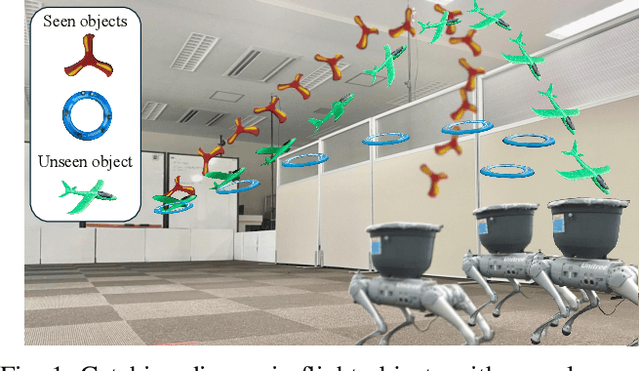
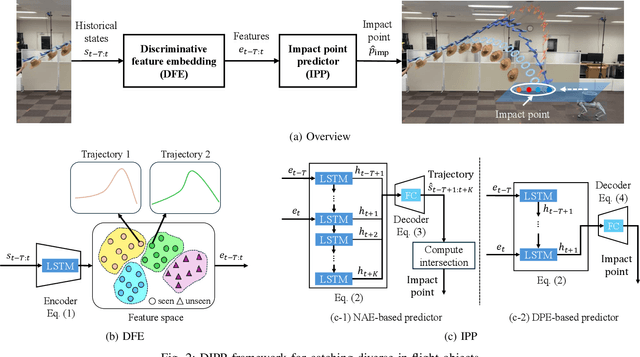
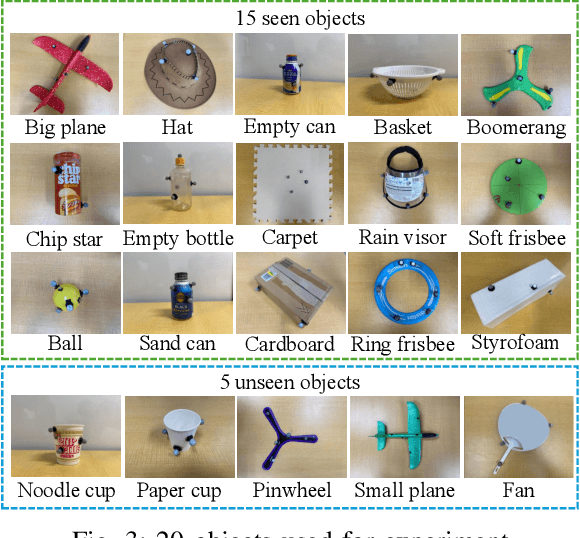
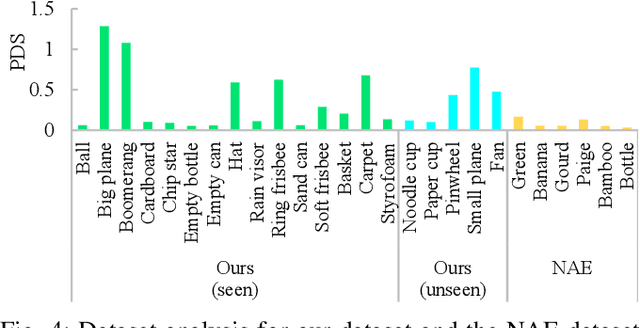
Abstract:In this study, we address the problem of in-flight object catching using a quadruped robot with a basket. Our objective is to accurately predict the impact point, defined as the object's landing position. This task poses two key challenges: the absence of public datasets capturing diverse objects under unsteady aerodynamics, which are essential for training reliable predictors; and the difficulty of accurate early-stage impact point prediction when trajectories appear similar across objects. To overcome these issues, we construct a real-world dataset of 8,000 trajectories from 20 objects, providing a foundation for advancing in-flight object catching under complex aerodynamics. We then propose the Discriminative Impact Point Predictor (DIPP), consisting of two modules: (i) a Discriminative Feature Embedding (DFE) that separates trajectories by dynamics to enable early-stage discrimination and generalization, and (ii) an Impact Point Predictor (IPP) that estimates the impact point from these features. Two IPP variants are implemented: an Neural Acceleration Estimator (NAE)-based method that predicts trajectories and derives the impact point, and a Direct Point Estimator (DPE)-based method that directly outputs it. Experimental results show that our dataset is more diverse and complex than existing dataset, and that our method outperforms baselines on both 15 seen and 5 unseen objects. Furthermore, we show that improved early-stage prediction enhances catching success in simulation and demonstrate the effectiveness of our approach through real-world experiments. The demonstration is available at https://sites.google.com/view/robot-catching-2025.
Prolonging Tool Life: Learning Skillful Use of General-purpose Tools through Lifespan-guided Reinforcement Learning
Jul 23, 2025Abstract:In inaccessible environments with uncertain task demands, robots often rely on general-purpose tools that lack predefined usage strategies. These tools are not tailored for particular operations, making their longevity highly sensitive to how they are used. This creates a fundamental challenge: how can a robot learn a tool-use policy that both completes the task and prolongs the tool's lifespan? In this work, we address this challenge by introducing a reinforcement learning (RL) framework that incorporates tool lifespan as a factor during policy optimization. Our framework leverages Finite Element Analysis (FEA) and Miner's Rule to estimate Remaining Useful Life (RUL) based on accumulated stress, and integrates the RUL into the RL reward to guide policy learning toward lifespan-guided behavior. To handle the fact that RUL can only be estimated after task execution, we introduce an Adaptive Reward Normalization (ARN) mechanism that dynamically adjusts reward scaling based on estimated RULs, ensuring stable learning signals. We validate our method across simulated and real-world tool use tasks, including Object-Moving and Door-Opening with multiple general-purpose tools. The learned policies consistently prolong tool lifespan (up to 8.01x in simulation) and transfer effectively to real-world settings, demonstrating the practical value of learning lifespan-guided tool use strategies.
Robotic System for Chemical Experiment Automation with Dual Demonstration of End-effector and Jig Operations
Jun 13, 2025Abstract:While robotic automation has demonstrated remarkable performance, such as executing hundreds of experiments continuously over several days, it is challenging to design a program that synchronizes the robot's movements with the experimental jigs to conduct an experiment. We propose a concept that enables the automation of experiments by utilizing dual demonstrations of robot motions and jig operations by chemists in an experimental environment constructed to be controlled by a robot. To verify this concept, we developed a chemical-experiment-automation system consisting of jigs to assist the robot in experiments, a motion-demonstration interface, a jig-control interface, and a mobile manipulator. We validate the concept through polymer-synthesis experiments, focusing on critical liquid-handling tasks such as pipetting and dilution. The experimental results indicate high reproducibility of the demonstrated motions and robust task-success rates. This comprehensive concept not only simplifies the robot programming process for chemists but also provides a flexible and efficient solution to accommodate a wide range of experimental conditions, contributing significantly to the field of chemical experiment automation.
Where Do We Look When We Teach? Analyzing Human Gaze Behavior Across Demonstration Devices in Robot Imitation Learning
Jun 06, 2025Abstract:Imitation learning for acquiring generalizable policies often requires a large volume of demonstration data, making the process significantly costly. One promising strategy to address this challenge is to leverage the cognitive and decision-making skills of human demonstrators with strong generalization capability, particularly by extracting task-relevant cues from their gaze behavior. However, imitation learning typically involves humans collecting data using demonstration devices that emulate a robot's embodiment and visual condition. This raises the question of how such devices influence gaze behavior. We propose an experimental framework that systematically analyzes demonstrators' gaze behavior across a spectrum of demonstration devices. Our experimental results indicate that devices emulating (1) a robot's embodiment or (2) visual condition impair demonstrators' capability to extract task-relevant cues via gaze behavior, with the extent of impairment depending on the degree of emulation. Additionally, gaze data collected using devices that capture natural human behavior improves the policy's task success rate from 18.8% to 68.8% under environmental shifts.
DAPPER: Discriminability-Aware Policy-to-Policy Preference-Based Reinforcement Learning for Query-Efficient Robot Skill Acquisition
May 09, 2025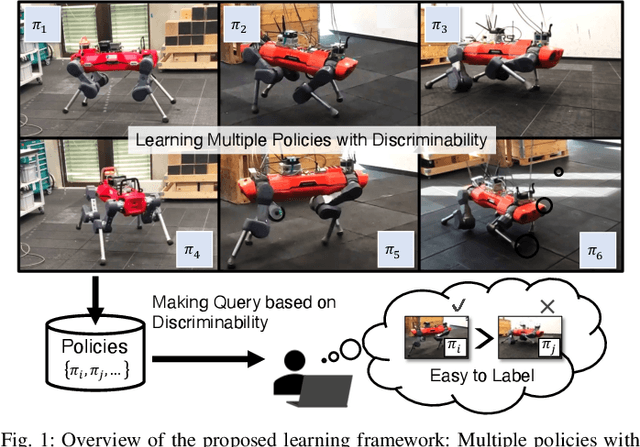
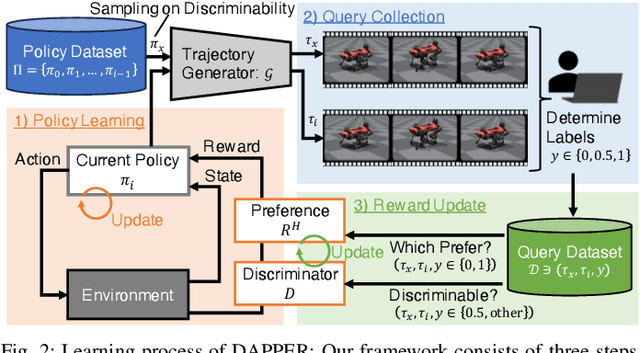
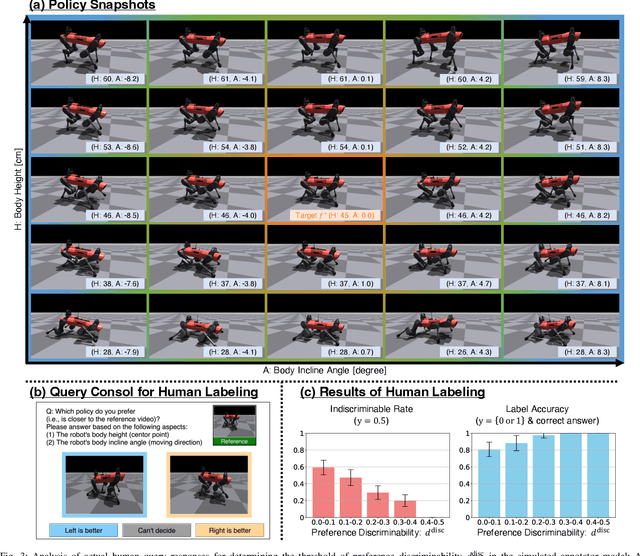
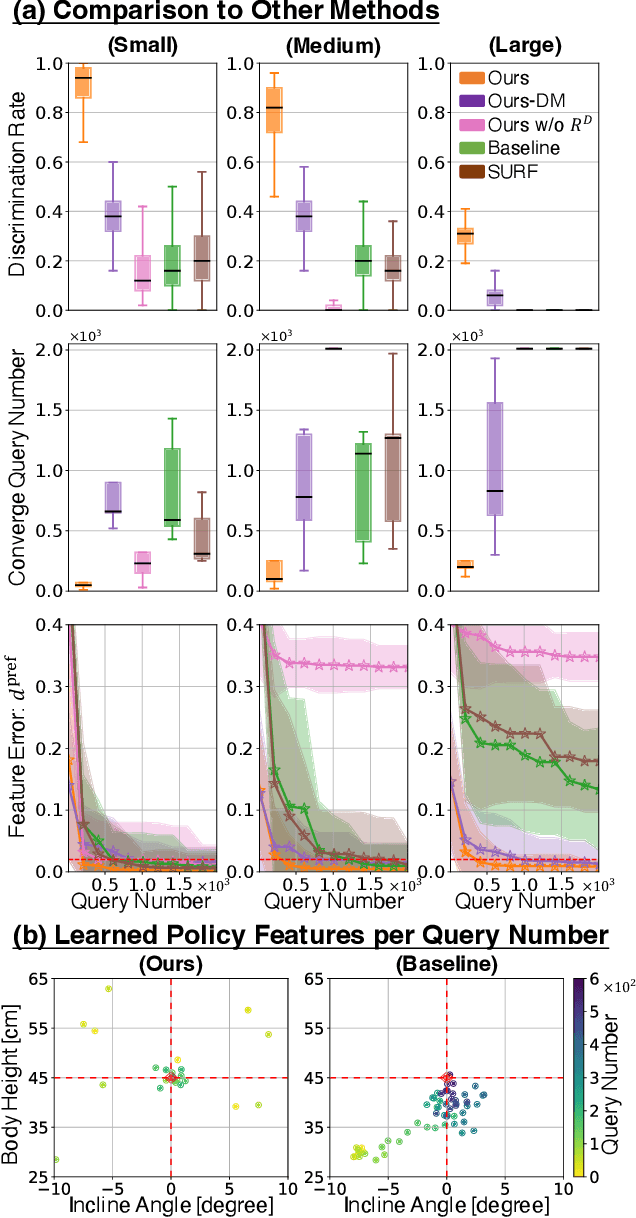
Abstract:Preference-based Reinforcement Learning (PbRL) enables policy learning through simple queries comparing trajectories from a single policy. While human responses to these queries make it possible to learn policies aligned with human preferences, PbRL suffers from low query efficiency, as policy bias limits trajectory diversity and reduces the number of discriminable queries available for learning preferences. This paper identifies preference discriminability, which quantifies how easily a human can judge which trajectory is closer to their ideal behavior, as a key metric for improving query efficiency. To address this, we move beyond comparisons within a single policy and instead generate queries by comparing trajectories from multiple policies, as training them from scratch promotes diversity without policy bias. We propose Discriminability-Aware Policy-to-Policy Preference-Based Efficient Reinforcement Learning (DAPPER), which integrates preference discriminability with trajectory diversification achieved by multiple policies. DAPPER trains new policies from scratch after each reward update and employs a discriminator that learns to estimate preference discriminability, enabling the prioritized sampling of more discriminable queries. During training, it jointly maximizes the preference reward and preference discriminability score, encouraging the discovery of highly rewarding and easily distinguishable policies. Experiments in simulated and real-world legged robot environments demonstrate that DAPPER outperforms previous methods in query efficiency, particularly under challenging preference discriminability conditions.
KeyMPs: One-Shot Vision-Language Guided Motion Generation by Sequencing DMPs for Occlusion-Rich Tasks
Apr 14, 2025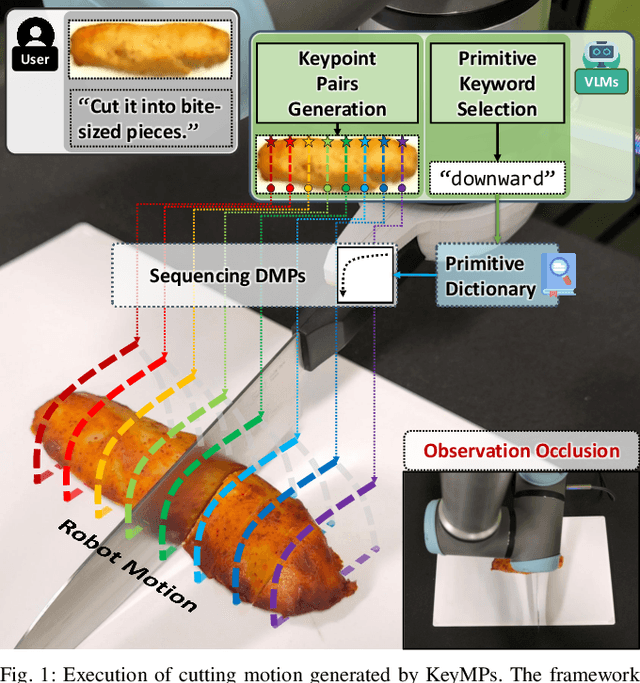
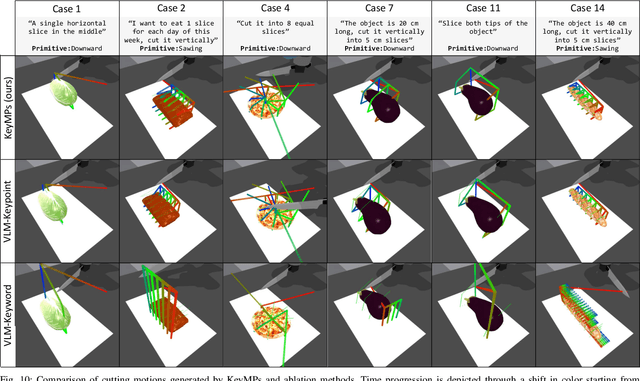

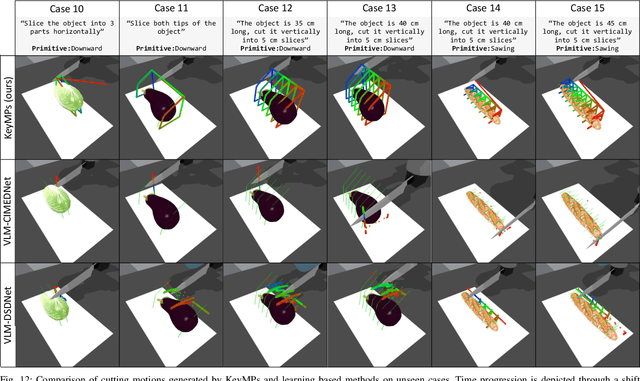
Abstract:Dynamic Movement Primitives (DMPs) provide a flexible framework wherein smooth robotic motions are encoded into modular parameters. However, they face challenges in integrating multimodal inputs commonly used in robotics like vision and language into their framework. To fully maximize DMPs' potential, enabling them to handle multimodal inputs is essential. In addition, we also aim to extend DMPs' capability to handle object-focused tasks requiring one-shot complex motion generation, as observation occlusion could easily happen mid-execution in such tasks (e.g., knife occlusion in cake icing, hand occlusion in dough kneading, etc.). A promising approach is to leverage Vision-Language Models (VLMs), which process multimodal data and can grasp high-level concepts. However, they typically lack enough knowledge and capabilities to directly infer low-level motion details and instead only serve as a bridge between high-level instructions and low-level control. To address this limitation, we propose Keyword Labeled Primitive Selection and Keypoint Pairs Generation Guided Movement Primitives (KeyMPs), a framework that combines VLMs with sequencing of DMPs. KeyMPs use VLMs' high-level reasoning capability to select a reference primitive through keyword labeled primitive selection and VLMs' spatial awareness to generate spatial scaling parameters used for sequencing DMPs by generalizing the overall motion through keypoint pairs generation, which together enable one-shot vision-language guided motion generation that aligns with the intent expressed in the multimodal input. We validate our approach through an occlusion-rich manipulation task, specifically object cutting experiments in both simulated and real-world environments, demonstrating superior performance over other DMP-based methods that integrate VLMs support.
BEAC: Imitating Complex Exploration and Task-oriented Behaviors for Invisible Object Nonprehensile Manipulation
Mar 21, 2025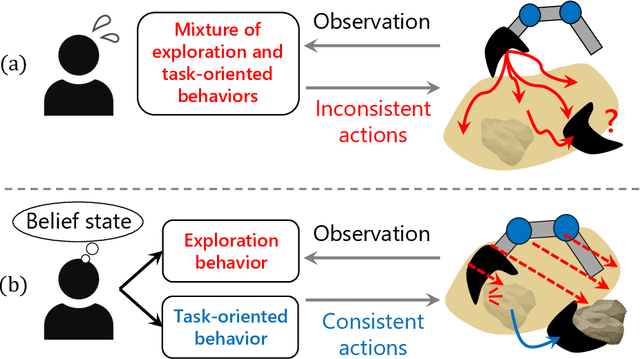
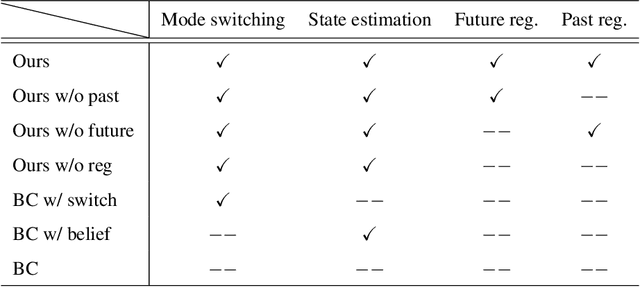
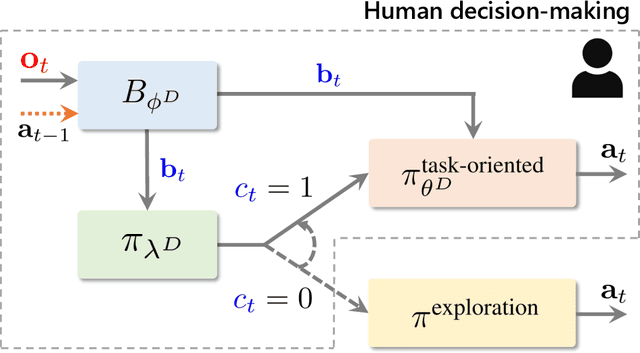
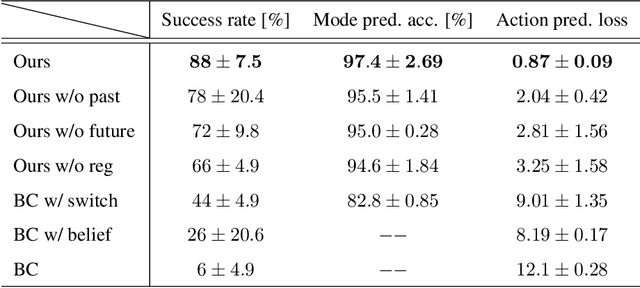
Abstract:Applying imitation learning (IL) is challenging to nonprehensile manipulation tasks of invisible objects with partial observations, such as excavating buried rocks. The demonstrator must make such complex action decisions as exploring to find the object and task-oriented actions to complete the task while estimating its hidden state, perhaps causing inconsistent action demonstration and high cognitive load problems. For these problems, work in human cognitive science suggests that promoting the use of pre-designed, simple exploration rules for the demonstrator may alleviate the problems of action inconsistency and high cognitive load. Therefore, when performing imitation learning from demonstrations using such exploration rules, it is important to accurately imitate not only the demonstrator's task-oriented behavior but also his/her mode-switching behavior (exploratory or task-oriented behavior) under partial observation. Based on the above considerations, this paper proposes a novel imitation learning framework called Belief Exploration-Action Cloning (BEAC), which has a switching policy structure between a pre-designed exploration policy and a task-oriented action policy trained on the estimated belief states based on past history. In simulation and real robot experiments, we confirmed that our proposed method achieved the best task performance, higher mode and action prediction accuracies, while reducing the cognitive load in the demonstration indicated by a user study.
ICCO: Learning an Instruction-conditioned Coordinator for Language-guided Task-aligned Multi-robot Control
Mar 15, 2025Abstract:Recent advances in Large Language Models (LLMs) have permitted the development of language-guided multi-robot systems, which allow robots to execute tasks based on natural language instructions. However, achieving effective coordination in distributed multi-agent environments remains challenging due to (1) misalignment between instructions and task requirements and (2) inconsistency in robot behaviors when they independently interpret ambiguous instructions. To address these challenges, we propose Instruction-Conditioned Coordinator (ICCO), a Multi-Agent Reinforcement Learning (MARL) framework designed to enhance coordination in language-guided multi-robot systems. ICCO consists of a Coordinator agent and multiple Local Agents, where the Coordinator generates Task-Aligned and Consistent Instructions (TACI) by integrating language instructions with environmental states, ensuring task alignment and behavioral consistency. The Coordinator and Local Agents are jointly trained to optimize a reward function that balances task efficiency and instruction following. A Consistency Enhancement Term is added to the learning objective to maximize mutual information between instructions and robot behaviors, further improving coordination. Simulation and real-world experiments validate the effectiveness of ICCO in achieving language-guided task-aligned multi-robot control. The demonstration can be found at https://yanoyoshiki.github.io/ICCO/.
Feasibility-aware Imitation Learning from Observations through a Hand-mounted Demonstration Interface
Mar 12, 2025Abstract:Imitation learning through a demonstration interface is expected to learn policies for robot automation from intuitive human demonstrations. However, due to the differences in human and robot movement characteristics, a human expert might unintentionally demonstrate an action that the robot cannot execute. We propose feasibility-aware behavior cloning from observation (FABCO). In the FABCO framework, the feasibility of each demonstration is assessed using the robot's pre-trained forward and inverse dynamics models. This feasibility information is provided as visual feedback to the demonstrators, encouraging them to refine their demonstrations. During policy learning, estimated feasibility serves as a weight for the demonstration data, improving both the data efficiency and the robustness of the learned policy. We experimentally validated FABCO's effectiveness by applying it to a pipette insertion task involving a pipette and a vial. Four participants assessed the impact of the feasibility feedback and the weighted policy learning in FABCO. Additionally, we used the NASA Task Load Index (NASA-TLX) to evaluate the workload induced by demonstrations with visual feedback.
Disentangled Iterative Surface Fitting for Contact-stable Grasp Planning
Feb 17, 2025Abstract:In this work, we address the limitation of surface fitting-based grasp planning algorithm, which primarily focuses on geometric alignment between the gripper and object surface while overlooking the stability of contact point distribution, often resulting in unstable grasps due to inadequate contact configurations. To overcome this limitation, we propose a novel surface fitting algorithm that integrates contact stability while preserving geometric compatibility. Inspired by human grasping behavior, our method disentangles the grasp pose optimization into three sequential steps: (1) rotation optimization to align contact normals, (2) translation refinement to improve Center of Mass (CoM) alignment, and (3) gripper aperture adjustment to optimize contact point distribution. We validate our approach through simulations on ten YCB dataset objects, demonstrating an 80% improvement in grasp success over conventional surface fitting methods that disregard contact stability. Further details can be found on our project page: https://tomoya-yamanokuchi.github.io/disf-project-page/.
 Add to Chrome
Add to Chrome Add to Firefox
Add to Firefox Add to Edge
Add to Edge